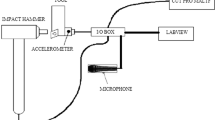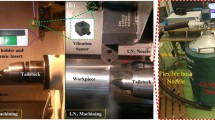Abstract
Machining method and its outcomes are significant in manufacturing operations, but determined vibrations in the process, quite hard to solve, rising from the natural mechanism of the process. Numerous parameters affect the machinability outcomes, such as surface roughness, chip morphology, tool wear, and fluctuations in the process. In this paper, 15°, 30°, and 45° approach angles, 1, 3, 5, 10, and 15 chip slenderness ratios (CSR), selected as the ratio of the cutting depth to the feed rate, were selected. Therefore, the effects of the cutting edge approach angle and CSR on the conclusions were investigated. At 15° approach angle, the severe and unstable vibrations were recorded, including the cracks, the chip serration with high pitch size, hard distortion cracks, and the largest tool wear areas which were observed on-chip morphology, but only at low CSR values and 45° approach angle. The highest fluctuations were taken place in the direction of cutting depth (X), for all selected parameters. The optimum results were recorded at 30° approach angle and 15 CSR, but the hardest deformation cracks seemed at 1 CSR. Additionally, Co, involved in the structure of the cutting tool as a binder, transfer to the removed chip, while Fe, from the workpiece to the cutting tool, during the process.











Similar content being viewed by others
References
Kronenberg M (1996) Machining science and application theory and practice for operation and development of machining processes. Arrowsmit Ltd., Bristol, pp 170–182
Sun Z, Shuang F, Ma W (2018) Investigations of vibration cutting mechanisms of Ti6Al4V alloy. Int J Mech Sci 48:510–530. https://doi.org/10.1016/j.ijmecsci.2018.09.006
Su G, Liu Z, Li L, Wang B (2015) Influences of chip serration on micro-topography of machined surface in high-speed cutting. Int J Mach Tools Manuf 89:202–207. https://doi.org/10.1016/j.ijmactools.2014.10.012
Zhang G, Guo C (2015) Modeling of cutting force distribution on tool edge in turning process. Procedia Manuf 1:454–465
Zhang X, Arif M, Liu K, Kumar AS, Rahman M (2013) A model to predict the critical undeformed chip thickness in vibration-assisted machining of brittle materials. Int J Mach Tools Manuf 69:57–66
Bordin A, Bruschi S, Ghiotti A (2014) The effect of cutting speed and feed rate on the surface integrity in dry turning of CoCrMo alloy. Procedia CIRP 13:219–224
Nesluŝan M, Ŝípek M, Mrázik J (2012) Analysis of chip formation during hard turning through acoustic emission. Mater Eng 19:1–11
Cui X, Guo J (2017) Effect of cutting parameters on tool temperatures in intermittent turning with the formation of serrated chip considered. Appl Therm Eng 110:1220–1229. https://doi.org/10.1016/j.applthermaleng.2016.09.048
Munoa J, Beudaert X, Erkorkmaz K, Iglesias A, Barrios A (2015) Active suppression of structural chatter vibrations using machine drives and accelerometers. CIRP Ann Manuf Technol 64:385–388. https://doi.org/10.1016/j.cirp.2015.04.1016
Das D, Sahoo BP, Bansal S, Mishra P (2018) Experimental investigation on material removal rate and chip forms during T6 tempered Al 7075 alloy. Mater Today Proc 5:3250–3256
Magdum VB (2016) Investigate the effect of approaching angle on cutting force during EN 8 steel turning. Int J Comput Eng Res Trends 3(9):471–475
Zhang SJ, To S, Wang SJ, Zhu ZW (2015) A review of surface roughness generation in ultra-precision machining. Int J Mach Tools Manuf 91:76–95. https://doi.org/10.1016/j.ijmactools.2015.02.001
Ramanaiah BV, Manikanta B, Sankar MR, Malhotra M, Gajrani KK (2018) Experimental study of deflection and surface roughness in thin wall machining of aluminium alloy. Mater Today Proc 5:3745–3754
Yan L, Zhang Q, Yu J (2018) Analytical models for oil penetration and experimental study on vibration assisted machining with minimum quantity lubrication. Int J Mech Sci 148:374–382. https://doi.org/10.1016/j.ijmecsci.2018.09.016
Zhu Z, Guo K, Sun J, Li J, Liu Y, Chen L, Zheng Y (2018) Evolution of 3D chip morphology and phase transformation in dry drilling Ti6Al4V alloys. J Manuf Process 34:531–539. https://doi.org/10.1016/j.jmapro.2018.07.001
Acknowledgements
The authors also thank to Assoc. Dr Murat Yavuz (Dicle University Science and Technology Research and Application Center (DUBTAM) for SEM images and EDAX analysing.
Author information
Authors and Affiliations
Corresponding author
Additional information
Technical Editor: Marcelo Areias Trindade.
Publisher's Note
Springer Nature remains neutral with regard to jurisdictional claims in published maps and institutional affiliations.
Rights and permissions
About this article
Cite this article
Demir, Z., Adiyaman, O. Investigation of influence of approach angle and chip slenderness ratio on vibration, chip formation and surface quality in turning of AISI 1050 steel. J Braz. Soc. Mech. Sci. Eng. 41, 467 (2019). https://doi.org/10.1007/s40430-019-1977-3
Received:
Accepted:
Published:
DOI: https://doi.org/10.1007/s40430-019-1977-3




